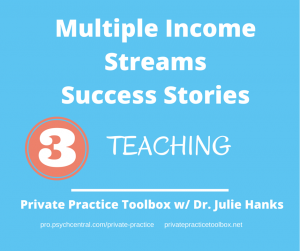As therapists in 2016, we understand that having a functioning, informational, and attractive website isn’t just a good idea-it’s a necessity. But if you’re just starting out in private practice, it can be intimidating to build one from the ground up. How do you design your home page so a user can easily navigate and find what they need? How do you present information in a way that isn’t overwhelming or too “busy”? What’s the best way to make sure your content is mobile-friendly? And even when you figure out the answers to these questions, how do you make the vision in your head actually become reality on a website?
How Media Marketing Can Build Your Practice: Podcast Interview
One of my favorite colleagues and friends, Joe Sanok from Practice of the Practice, invited me to join him for a podcast interview on how to get media coverage for your private practice and maximize it to build your online presence, build trust with potential clients who are willing to pay your full fee. We had a great time chatting about my journey to build a media presence and how it's directly correlated with the growth of my private practice. After intentionally doing media interviews my practice grew from a few people to 3 locations and 20 therapists!
I also give nitty-gritty details about my Rock the Media School for therapists online e-course that begins in 2 weeks. The 6 week e-course will walk you through how to identify who you want to reach, how to gain local and/or national media exposure, and how to use those interviews to build trust, boost your credibility, and attract clients who are willing to pay your full fee. Listen to the podcast here
Are you ready to grow your media and social media presence? My first cohort of Rock the Media School for Therapists starts Sept. 7! Get details and sign up here
Therapist Blog Challenge #21: Maintaining Space in a Relationship
 I'm excited to present a blog challenge that has to do with one of my favorite topics: relationships. Specifically, you'll have the chance to explore the idea of how a person can maintain his/her own space (physically and emotionally) while also being in a relationship.
I'm excited to present a blog challenge that has to do with one of my favorite topics: relationships. Specifically, you'll have the chance to explore the idea of how a person can maintain his/her own space (physically and emotionally) while also being in a relationship.
[Headline] Come up with a headline to give your readers an idea of what is to come. Here are a few examples:
"'Give Me Some Space!' Maintaining Healthy Boundaries in Relationships"
"Creating an Appropriate Amount of (Emotional) Space With Your Significant Other"
"Absence Makes The Heart Grow Fonder; How Spending Time Away From Your Spouse Can Strengthen Your Connection"
"Preserve Your Relationship By Taking Time For Yourself!"
[Strong Intro] Write an introductory paragraph to explain the topic more and lay the scene for your main points. You may write your own or use the following:
Movies and pop culture often portray two people in love as inseparable and completely enamored with one another. Some struggle when they realize that the experience of real life can be quite different. The truth is that almost everyone in a relationship needs a little personal space and even time away. But how can you get a breather while still maintaining your relationship? Here are some reasons why space is important and also ways to create boundaries and still keep your connection strong:
[Scanable Content] Break up your content to make it more digestible and easy to read. Under each point, flesh out your idea by elaborating on your thoughts.
1. Tune In To Your Feelings
Acknowledging your emotions that you need a little space in your relationship is the first step. Maybe you're feeling a bit cut off from other people or are even feeling a bit smothered. Some may be inclined to ignore such feelings or consider them "bad," but instead express to yourself if you are wanting a bit of a breather from your significant other.
2. Communicate About Your Needs
It may be a bit tricky, but tactfully communicate that you would like to branch out a bit. Be careful to let the other person know that you are not ending the relationship, but just want to find ways to enrich your life and experience. Express how you are feeling, and listen to your love's response; it's possible that he/ she is wanting the same thing!
3. Pursue Your Individual Passions
Take time to "get to know yourself" and do something that you enjoy (but perhaps have been neglecting). Go ahead and sign up for that pottery class, or recommit yourself to your exercise regimen that has suffered a bit. Encourage the other person to likewise engage in activities that he/ she likes.
4. Nourish Your Friendships
Although your spouse or significant other is likely your "number one," remember that no single person can fulfill all of your needs. We as humans are wired to connect, and we have something to learn from different people in our lives. Moreover, there is likely someone in your circle of influence who needs you, so take a break for a day or two and spend an evening with a friend.
5. Come Back Together Stronger Than Before
If you need some space and give yourself permission to take it, you're practicing self-care and can become even closer to your significant other. Famed German psychologist Erik Erikson explained that "identity precedes intimacy." Paradoxically, your relationship can be strengthened by developing your self and then creating and maintaining space!
[Strong ending paragraph] Wrap up your post by summarizing your main points to conclude and then possibly offering a further idea or two for readers or a call to action. Here’s an example:
Relationships need a lot to thrive: time, love, honesty, and connection. But each person taking time for him/ herself is an important (and sometimes overlooked) component in creating and maintaining a strong and healthy relationship. Tune in to your feelings, communicate, spend time with your friends and doing what you like, and come back together stronger than before.
Additional reminders about the 2015 blog challenge
- Write and post your blog article in the next 2 weeks. If you miss the deadline or you read this article months later, that’s OK too. Post a link for this blog challenge in the comment section of this blog post.
- Read, comment, and share other therapist’s articles.
- Tweet your post using hashtag #therapistblog and tag @drjuliehanks so I can retweet it.
- Pin it on the challenge Pinterest Board. I’ve invited everyone who posted a comment on the initial blog challenge post as collaborators so you can pin onto the group board.
- Spread the word and invite mental health colleagues to join the challenge. Articles can be added anytime throughout the year.
- Write no more than 600 words, make it easy to read, use a conversational tone, and gear your articles toward your ideal client (not other professionals).
- The goal of a professional blog is to provide value to your website visitors, help them get to know your professional perspective, increase traffic to your private practice website, and build your practice.
Join my Private Practice Toolbox Facebook group and connect with 3100 therapists around the globe in 2 simple steps: 1) Click request to join the group and 2) Fill out this brief questionnaire before you’ll be added to the group.Get practice tips and blog updates in your inbox.
Get 52 FREE Blog Topics and prompts when you sign up for the PPT Newsletter (that’s a year's worth of weekly blog posts!)
Multiple Income Stream Success Story #3: Teaching
 As we highlight more opportunities to use things that you enjoy doing and instances where others request your services to generate multiple income streams, I am sharing stories of other practitioners who have found ways to do just that:
We often forget that we have achieved at least a master's level education that can qualify us to teach others. There are many opportunities out there for teaching. Consider these options if teaching others is a passion for you. Teaching university or college courses, online courses or webinars, community workshops, or professional trainings.
As we highlight more opportunities to use things that you enjoy doing and instances where others request your services to generate multiple income streams, I am sharing stories of other practitioners who have found ways to do just that:
We often forget that we have achieved at least a master's level education that can qualify us to teach others. There are many opportunities out there for teaching. Consider these options if teaching others is a passion for you. Teaching university or college courses, online courses or webinars, community workshops, or professional trainings.
Getting started with teaching can be very easy; start with who you know. Contact your alma mater or other nearby colleges and universities. Many universities have positions available for adjunct faculty to teach entry level classes or to offer professional trainings to students in your field. Keep in mind, these types of teaching commitments usually last for extended periods, so be sure that they work for your timeline and make sense financially.
Presenting or developing online courses or webinars can be an easy, passive source of income. Once a training has been developed, you can easily record it and make it available for download or schedule various presentation times to virtually present it to others. This is an excellent area where your expertise can lead you to topics or needed courses. It also allows you the opportunity to reach well beyond the scope of your geographical location.
Starting small can often lead you to bigger opportunities and income growth. Consider providing small trainings at your practice for continuing education credits. Pam Dyson, MA, LPC, did just that when starting her play therapy trainings. When Pam originally started with trainings, it worked out to about 25% of her income. As those trainings became more successful Pam grew those trainings to the point where they provide 75% of her income. Pam shares this about her experience in growing teaching as an income stream.
“In 2010, I became an Approved Provider for the Association for Play Therapy. I began by offering a day long play therapy training, once a month, out of my private practice office, where attendees could earn the clock hours needed to become an RPT. I set up a website to promote the trainings, and within a year I was at capacity for each training. To meet the demand, I began offering four day-long trainings per month."
If you would like to learn more about Pam Dyson and the trainings that she offers, please visit DFW Play Therapy Training.
Community workshops are another area where teaching can be a beneficial source of income. Workshops are excellent because they often don't take much time to develop and also only last for brief periods. In my practice, we have sometimes taken areas or groups of individuals who have a need for instruction in a particular area and turned that into a workshop. I have done this when I see a consistent or similar problem in my clientele. At one point, I was working with many women who were suffering from a lack of sex drive. I developed a workshop for cultivating desire in marriage that I would present for a few hours every few months.
I encourage you to keep in mind doing those things that you are passionate about. Teaching may not be your cup of tea, but there are plenty of other ways to generate multiple streams of income. If you're still having trouble coming up with something, refer back to my 5 Key Questions to help you get started.
Visit the new PrivatePracticeToolbox.net for webinars and consulting services
Visit the new PrivatePracticeToolbox.net for webinars and consulting services
FREE Download Get 52 Blog Post Topics & prompts when you sign up for PPT list
Join my Private Practice Toolbox Facebook group and connect with 3200 therapists around the globe in 2 simple steps: 1) Click request to join the group and 2) Fill out this brief questionnaire before you’ll be added to the group.
Therapist Blog Challenge #20: Athletes and Mental Health
 Therapist Blog Challenge #20 deals with the sometimes misunderstood topic of the mental challenges that athletes may experience.
Therapist Blog Challenge #20 deals with the sometimes misunderstood topic of the mental challenges that athletes may experience.
[Headline] Come up with a headline to give your readers an idea of what is to come. Here are a few examples:
Athletes' Unique Struggles With Mental Illness
Why Athletes Are Not Immune to Mental Health Challenges
Depression and Anxiety in Athletic Competitors
[Strong Intro] Write an introductory paragraph to explain more the topic and lay the scene for your main points. You may write your own or use the following:
Athletes are the envy of many in our society. Whether they're professionals, college players, or even high schoolers who excel in sports, it's not uncommon to desire their physical strength, attractive appearance, and mental grit. But what some may not understand is that athletes are just as vulnerable to mental health problems as the rest of the population. In fact, they often face unique struggles concerning their psychological well-being. According to some estimates, as many as 1 in 5 athletes experiences some form of a mood disorder. Here are 4 common reasons why athletes may struggle with mental illness:
[Scanable Content] Break up your content to make it more digestible and easy to read. Under each point, flesh out your idea by elaborating on your thoughts.
Athletes Often Tie Their Self-Worth To Their Performance
Athletes may experience feelings of worthlessness or extreme disappointment if they lose a game or match or otherwise do not perform at the level they desire. As losing (and even failing) is an inherent part of sports, this can occur quite frequently and therefore take an emotional toll that may leave these individuals prone to situational depression.
Frequent Injuries
Depending on the specific sport of event, some athletes may get hurt quite regularly. Head injuries (particularly concussions) sometimes seen with football players can lead to depression. Also, injuries that sideline athletes can cause them to feel incomplete or incompetent, which may further trouble them emotionally; if sports is what an individual excels at, he/she may feel like there is nothing else without them.
Associate Mental Illness With Weakness
As athletics emphasizes strength, having an "off-day" or being otherwise psychologically low may come off as weakness. Coaches and players may exacerbate this idea, and athletes can feel even worse about themselves if they are experiencing extreme sadness, anxiety, or other uncomfortable emotions resulting from a mental illness. There is already enough societal stigma concerning this topic, and this may even be more so in the world of athletics.
High Stress and Pressure
Everyone experiences the stress of everyday life, but that felt during an athletic event is even more intense. As an athlete's paycheck (and pride) depends on their performance, the stress and anxiety can sometimes prove too much and create a heavy psychological burden.
[Strong ending paragraph]
Wrap up your post by summarizing your main points to conclude and then possibly offering a further idea or two for readers to investigate on their own. Here's an example:
The nature of sports and competitiveness presents unique challenges for athletes. Thankfully, we can raise awareness of this issue in the hopes or reaching more individuals who may need professional help. Visit the International Society for Sports Psychiatry (ISSP) for more information.
Additional reminders about the 2015 blog challenge
- Write and post your blog article in the next 2 weeks. If you miss the deadline or you read this article months later, that’s OK too. Post a link for this blog challenge in the comment section of this blog post.
- Read, comment, and share other therapist’s articles.
- Tweet your post using hashtag #therapistblog and tag @julie_hanks so I can retweet it.
- Pin it on the challenge Pinterest Board. I’ve invited everyone who posted a comment on the initial blog challenge post as collaborators so you can pin onto the group board.
- Spread the word and invite mental health colleagues to join the challenge. Articles can be added anytime throughout the year.
- Write no more than 600 words, make it easy to read, use a conversational tone, and gear your articles toward your ideal client (not other professionals).
- The goal of a professional blog is to provide value to your website visitors, help them get to know your professional perspective, increase traffic to your private practice website, and build your practice.
Join my Private Practice Toolbox Facebook group and connect with 3200 therapists around the globe in 2 simple steps: 1) Click request to join the group and 2) Fill out this brief questionnaire before you’ll be added to the group.Get practice tips and blog updates in your inbox.
Get 52 FREE Blog Topics and prompts when you sign up for the PPT Newsletter (that's a years worth of weekly blog posts!)



As healers, we genuinely like to do our work. Guiding clients through the therapy process and seeing them make progress is why we do what we do. But if you're in private practice, you know there's a lot going on in the back end and that it's crucial to run an efficient and organized business.